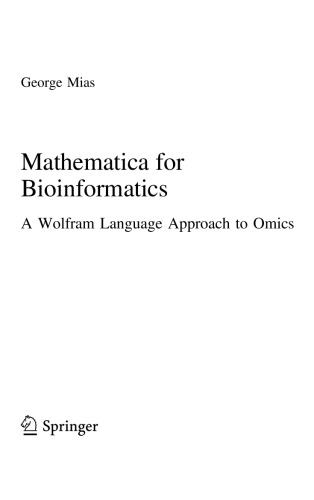این کتاب مقدمه ای جامع برای استفاده از ریاضیات و زبان Wolfram برای بیوانفورماتیک ارائه می دهد. فصلها به تدریج از مفاهیم اولیه و مقدمهای بر زبان Wolfram و مدلهای کدنویسی در Mathematica تا مثالهای عملی دقیق مشتقشده از برنامههای تحقیقاتی معمولی با استفاده از کد زبان Wolfram ساخته میشوند. نمونههای کدگذاری از تجزیه و تحلیل توالی اولیه، دسترسی به پایگاههای داده ژنومی، بیان ژن دیفرانسیل، و کاربردهای یادگیری ماشین گرفته تا تجزیه و تحلیل سریهای زمانی آزمایشهای omics طولی، ادغام چند مقیاسی، و ساخت ابزارهای بیوانفورماتیک تعاملی پویا با استفاده از زبان Wolfram را شامل میشود. موضوعات به نیازهای روزمره بیوانفورماتیک مخاطبان گسترده میپردازد: کاربران تجربی که به دنبال درک و تجسم دادههای خود هستند، کارشناسان جوان بیوانفورماتیک که تجربه کدنویسی در ارائه راهحلهای بیوانفورماتیک به دست میآورند، و متخصصان بیوانفورماتیکی که روی omics کار میکنند و میخواهند جعبه ابزار خود را به زبان Wolfram گسترش دهند. .
This book offers a comprehensive introduction to using Mathematica and the Wolfram Language for Bioinformatics. The chapters build gradually from basic concepts and the introduction of the Wolfram Language and coding paradigms in Mathematica, to detailed worked examples derived from typical research applications using Wolfram Language code. The coding examples range from basic sequence analysis, accessing genomic databases, differential gene expression, and machine learning implementations to time series analysis of longitudinal omics experiments, multi-omics integration and building dynamic interactive bioinformatics tools using the Wolfram Language. The topics address the daily bioinformatics needs of a broad audience: experimental users looking to understand and visualize their data, beginner bioinformaticians acquiring coding expertise in providing biological research solutions, and practicing expert bioinformaticians working on omics who wish to expand their toolset to include the Wolfram Language.




